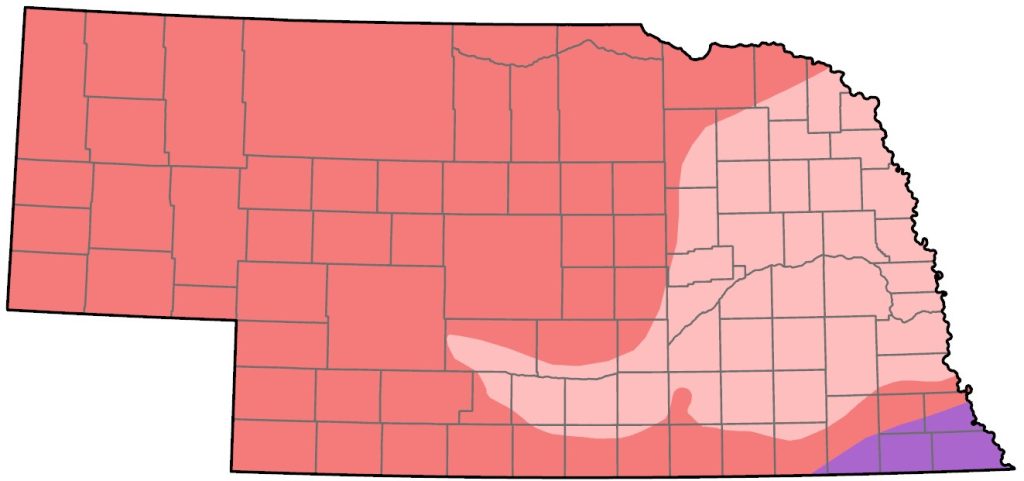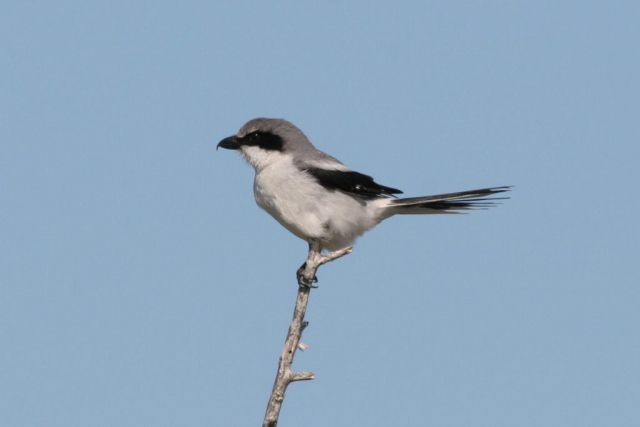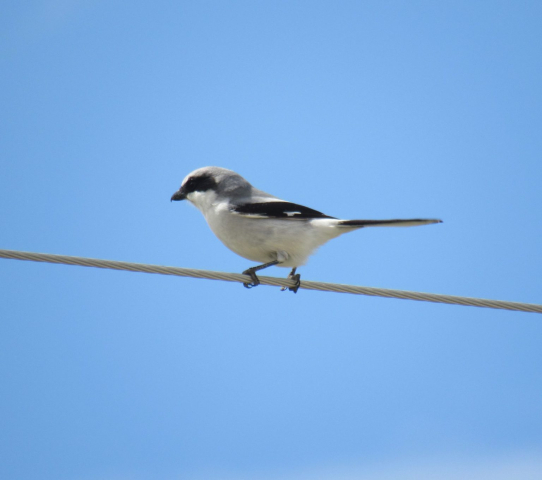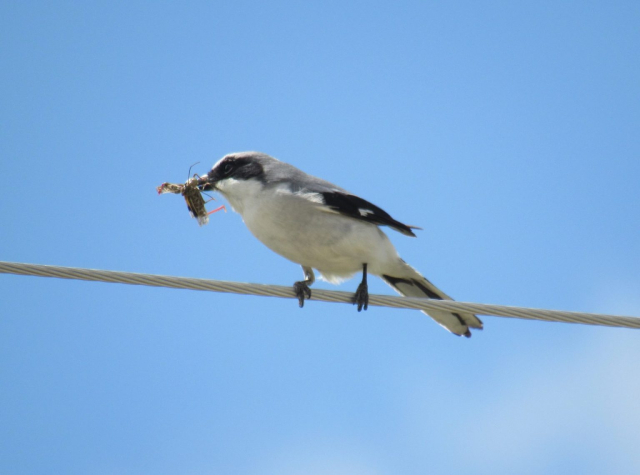Lanius ludovicianus excubitorides, L. l. migrans
Status: Fairly common regular spring and fall migrant statewide. Fairly common regular breeder central and west, uncommon east. Rare regular winter visitor southeast, rare casual elsewhere.
Documentation: Specimen: UNSM ZM6750, 5 Jun 1901 Warbonnet Canyon, Sioux Co.
Taxonomy: Seven subspecies are recognized (AviList 2025), three on the mainland north of Mexico, excubitorides of central Canada and the central and western USA, migrans of eastern North America, and ludovicianus of coastal southeast USA.
Most of the breeding Loggerhead Shrikes in Nebraska are probably intergrades of the Great Plains subspecies excubitorides and the widespread North American subspecies migrans (Rapp et al 1958). Those in the western half of the state may be fairly pure excubitorides, and those in the east mostly intergrades.
Changes Since 2000: Loggerhead Shrike numbers appear to have declined sharply in Nebraska in recent years, especially in areas dominated by row crop agriculture. Mollhoff (2016) stated the species was reported in 11% fewer blocks between the first (1986-1991) and second (2007-2012) BBA projects despite a marked increase in survey efforts during the second BBA. BBS trend data (Sauer et al 2020) show a notable annual decline of – 3.16 (95% C.I.; -4.56, -1.77) during the period 1966-2019. See discussion in Summer.
Spring: Mar 14, 14, 14 <<<>>> summer (away from extreme southeast)
Earlier dates away from the extreme southeast are 1 Mar in the northern Panhandle, unlikely to have wintered (Rosche 1982), 9 Mar 2024 Clay Co, 11 Mar 2011 Phelps Co, and 11 Mar 2007 Harlan Co.
- High counts: 29 in Keith Co 24 Apr 1999, 29 in the Panhandle 25 Apr 1999, and 23 there 1 May 2004.
Summer: Loggerhead Shrikes are most numerous in western Nebraska and the Panhandle, where pure excubitorides likely occurs; the population of this subspecies may be maintaining its numbers better than eastern birds, mostly migrans and intergrades between the two subspecies.
The decline in Loggerhead Shrike numbers in agricultural areas of Nebraska indicated by such data has been attributed by various authors (for example, Yosef 2020) to habitat destruction and pesticide use. That these causes may indeed be indicated in intensively cropped eastern and southern Nebraska is suggested by the fact that the lowest breeding numbers are in that area; lowest numbers for the state are in the Rainwater Basin, where Jorgensen (2012) considered the species a rare summer resident, formerly more common. Only four were reported in the northeast during summer 2021.
- Breeding Phenology:
Nest building: 29 Mar-20 Apr - Eggs: 14 Apr- 17 Jul (Mollhoff 2022)
Nestlings: 20 Apr- 3 Jul
Fledglings: 12 May-16 Aug
- High counts: 16 south of Exit 1 on Interstate 80 on 11 Jul 1998, 14 in southwest Kimball Co 8 Aug 1998, and 11 in Box Butte Co 16 Jun 1995.
There were 10 birds in three family groups in about five miles of Dodge Co road 1 Jul 2009. A total of 30 were counted along 22 miles in northern Sioux Co 17 Jul 2024.
Fall: summer <<<>>> Oct 28, 29, 29
Later dates are 31 Oct 2002 Lincoln Co, 2 Nov 2017 Lancaster Co, 4 Nov 1994 Dixon Co, 14 Nov 2011 Custer Co, and 1 Dec 2022 Keith Co.
This species winters in the southeast, and so dates listed above are away from the winter range as mapped above. Mid-Dec and later dates may be of birds attempting to overwinter (see Winter).
- High counts: 10 at Crescent Lake NWR 15 Aug 2015, 10 at Pine Bluffs in Kimball Co 14 Aug 2021, 7 at Exit 1, Interstate 80, Kimball Co 27 Aug 2019, and 7 there 16 Aug 2020.
Winter: There are usually fewer than three reports most winters and such reports are less-than-annual away from the extreme southeast as mapped above. CBC counts held in the first or second weeks of the count period recorded only around one bird per 100 party-hours. There is a specimen, UNSM ZM17545, taken 10 Jan 1997 in Butler Co, and one was photographed in Dodge Co 10 Jan 2008.
Additional mid-winter reports (2 Dec-29 Feb) away from the southeast are 13 Dec 1997 Sutherland Reservoir, Lincoln Co, 14 Dec 2017 Harlan County CBC, 14 Dec 2019 Harlan Co CBC, 16 Dec 1990 Lancaster Co, 18 Dec 1994 Loup City, Loup Co, 18 Dec 1998 Harlan Co, 24-27 Dec 2023 Frontier Co, 1 Jan 1996 Sherman Co (Brogie 1997), 2 Jan 2005 Beaver Valley CBC, Boone Co, 15 Jan 2013 Valley Co, 21 Jan 2001 Dixon Co, 5 Feb 2017 Johnson Co, 8 Feb 2013 Gage Co, 15 Feb 2015 Franklin Co, 20 Feb 2016 Gage Co, 20 Feb 2020 Gage Co, and 22 Feb 2004 Furnas Co.
There are no mid-winter records in the Panhandle, where it is “best to treat all wintering shrikes as Northerns, unless convincing published details or collected specimens prove otherwise” (Rosche 1982).
Images
Abbreviations
BBA: Breeding Bird Atlas
BBS: Breeding Bird Survey
CBC: Christmas Bird Count
NWR: National Wildlife Refuge
UNSM: University of Nebraska State Museum
Acknowledgement
Photograph (top) of a Loggerhead Shrike near Papillion, Sarpy Co 10 Apr 2005 by Phil Swanson.
Literature Cited
AviList Core Team, 2025. AviList: The Global Avian Checklist, v2025. https://doi.org/10.2173/avilist.v2025.
Brogie, M.A. 1997. 1996 (Eighth) Report of the NOU Records Committee. NBR 65: 115-126.
Jorgensen, J.G. 2012. Birds of the Rainwater Basin, Nebraska. Nebraska Game and Parks Commission, Lincoln, Nebraska, USA.
Mollhoff, W.J. 2016. The Second Nebraska Breeding Bird Atlas. Bull. Univ. Nebraska State Museum Vol 29. University of Nebraska State Museum, Lincoln, Nebraska, USA.
Mollhoff, W.J. 2022. Nest records of Nebraska birds. Nebraska Ornithologists’ Union Occasional Paper Number 9.
Rapp, W.F. Jr., J.L.C. Rapp, H.E. Baumgarten, and R.A. Moser. 1958. Revised checklist of Nebraska birds. Occasional Papers 5, Nebraska Ornithologists’ Union, Crete, Nebraska, USA.
Rosche, R.C. 1982. Birds of northwestern Nebraska and southwestern South Dakota, an annotated checklist. Cottonwood Press, Crawford, Nebraska, USA.
Sauer, J.R., W.A. Link, and J.E. Hines. 2020. The North American Breeding Bird Survey, Analysis Results 1966 – 2019: U.S. Geological Survey data release. https://doi.org/10.5066/P96A7675.
Yosef, R. 2020. Loggerhead Shrike (Lanius ludovicianus), version 1.0. In Birds of the World (A. F. Poole and F. B. Gill, Editors). Cornell Lab of Ornithology, Ithaca, NY, USA. https://doi.org/10.2173/bow.logshr.01.
Recommended Citation
Silcock, W.R., and J.G. Jorgensen. 2025. Loggerhead Shrike (Lanius ludovicianus). In Birds of Nebraska — Online. www.BirdsofNebraska.org
Birds of Nebraska – Online
Updated 17 Jul 2025, map updated 15 Jul 2022



